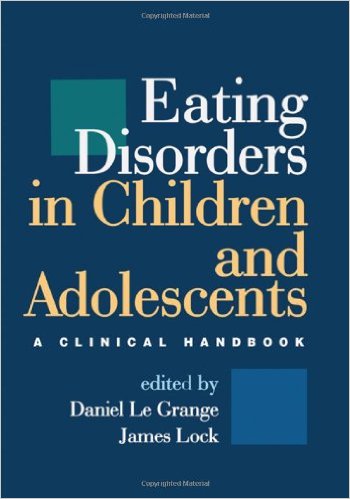
Reprinted from Eating Disorders Review
January/February 2012 Volume 23, Number 1
©2012 Gürze Books
Eating Disorders in Children and Adolescents A Clinical Handbook |
Our field has benefited greatly from several excellent clinical handbooks, but very few have been devoted solely to eating disorders issues in children and adolescents. In this outstanding volume Daniel Le Grange and James Lock, a clinical psychologist and child and an adolescent psychiatrist, who themselves contribute a great deal of important and well-regarded research and scholarship focusing on family-based treatment and other areas of work with adolescent populations, have brought together an international group of researchers and clinicians who provide up-to-date overviews of key themes and topics. These include not only the usual suspects, but some innovative areas of inquiry as well.
Organized in seven sections, the contributors address etiology and neurobiology, epidemiology and, of course, diagnosis and classification, medical issues and assessment, treatment, prevention and the role of parents. Of note and importance to clinicians, 10 of the 25 chapters concern treatment. In each chapter, the focus is on issues unique to or especially important to children and adolescents with eating disorders, as in assessment and treatment of medical conditions.
Many of the chapters are worthy of special comment, but space limits me to selecting just a few to illustrate the high value of this volume. After excellent introductory chapters on neurobiology and environmental and genetic risk factors, Michael Strober and Tara Peris undertake a unique consideration of “The role of family environment in etiology: a neuroscience perspective,” in which they skillfully integrate the developmental implications of genetics, epigenetics, neurobiology, temperament, different patterns of family dynamics and the impact of stress on biological and psychological development. There’s a great deal here for clinicians to comprehend and work with. The chapter on “Assessment of Eating Disorders in Children and Adolescents” by Katherine Loeb, Melanie Brown, and Michal Munk Goldstein, is rich with clinical examples comparing patients and parents as informants and a very useful and detailed summary of issues and recommendations for the assessment of diagnostic criteria in children and adolescents. The chapter includes a virtual consumers’ guide to the field of structured and semistructured interviews and rating scales for patients and parents available to clinicians and researchers. Starting off the treatment area, Mary Tantillo and Richard Kreipke focus on “Improving connections for adolescents across high-intensity settings for the treatment of eating disorders,” a critical topic about which little has been written. Their thoughtful discussion will be of value to all clinicians who find themselves attempting to provide “wrap-around” services by contending with and across different care settings and health-care institutions. The chapters on psychotherapy, including family-based, individual, and parent-focused, are excellent. A chapter on “A parent’s perspective on family treatment” by Harriet Brown is extremely instructive.
Lots of other highlights await the reader. Treatment teams can easily organize study and discussion groups for team-building and continuing education around these chapters. Clinicians serving children and adolescents with eating disorders and their families can find no better contemporary volume to guide their treatment.
— J.Y.

